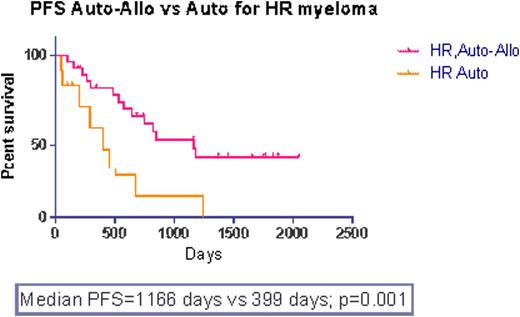Abstract
Aim/Background: The outcomes of high risk multiple myeloma (HR-MM) remain poor. As per the revised international staging system (R-ISS), high risk patients, defined by International Staging System (ISS) stage 3 plus high risk chromosomal abnormality and/or high Lactate Dehydrogenase (LDH), have particularly poor outcomes with 5 year progression free survival (PFS) and overall survival (OS) of 24% and 40% respectively.1 Tandem autologous - non-myeloablative allogeneic stem cell transplantation (ASCT-NMA AlloSCT), when used as upfront consolidation may improve the outcome via a graft versus myeloma effect. We performed a retrospective analysis comparing patients who had upfront tandem ASCT-NMA allo SCT for HR-MM with a HR-MM control group who were conventionally treated with upfront ASCT alone.
Method: From May 2008 to June 2015, 29 HR-MM patients were treated at the Alfred Hospital Melbourne, with upfront tandem ASCT-NMA alloSCT. HR-MM was defined by the presence of at least 2 of 5 high risk features including International Staging System (ISS) score III, adverse cytogenetics [t(4;14 and/or 17p- identified on FISH and/or complex karyotype on metaphase analysis], elevated lactate dehydrogenase (LDH), plasma cell leukemia (all at diagnosis) or induction failure (less than partial remission (PR)) with proteosome inhibitor (PI) or immunomodulator (IMID) based combination chemotherapy. Outcomes for these patients were compared with 12 HR-MM patients contemporaneously treated at the Royal Adelaide hospital, Adelaide with upfront ASCT alone. All ASCT were conditioned with melphalan 200mg/m2; NMA were conditioned with oral fludarabine 48mg/m2 on days -4 to -2 and 2Gy TBI on day 0. All tandem ASCT-NMA allo SCT patients received cyclosporine and mycophenylate mofetil for graft versus host disease prophylaxis.
Results: Median age of the tandem cohort was 52 years (range: 22-66 years) whereas the ASCT cohort was older with a median age of 59 years (range: 51-72 years; p=0.01). 44.8% of the tandem group and 50% of the ASCT group were male (p=0.77). 18 patients (62.1%) of the tandem cohort were transplanted from unrelated donors. Within the tandem cohort 24.1% developed grade II-IV acute graft versus host disease (GVHD) and 44.8% had extensive chronic GVHD. After a median follow up of 48.9 months, progression free survival (PFS) was significantly superior for tandem group compared to ASCT group (median PFS=1166 days versus 399 days; p=0.001) (Fig:1). The 3-year cumulative incidence of relapse was 31.9% for tandem group against 79.8% for ASCT group (p=0.005). The 5-year overall survival of tandem and ASCT groups were 59.84% and 44.56%, respectively (p=0.38). Transplant related mortality was not significantly different between the groups (20.7% for tandem group and 8.3% for ASCT group; p=0.32). To avoid any age bias, we then compared the ASCT cohort with an older subgroup of the tandem cohort (17 patients with a median age of 58 years, range: 51-66 years, p=0.61 when compared with ASCT cohort) and demonstrated that the PFS was still significantly superior for the tandem approach (median PFS=1179 days for tandem cohort versus 399 days for ASCT cohort; p=0.009). Minimal residual disease (MRD) analysis by 8-colour Euroflow (sensitivity at 10-5) was negative in 12 of 17 tandem patients tested.
Conclusion: Upfront tandem ASCT-NMA AlloSCT for HR-MM results in superior PFS and an emerging OS benefit with acceptable toxicity when compared to conventional ASCT. High-resolution MRD negativity in a significant proportion of tandem patients predicts for extended disease free survival.
Ref:
1. Palumbo A, Avet-Loiseau H, Oliva S, et al. Revised International Staging System for Multiple Myeloma: A Report From International Myeloma Working Group. J Clin Oncol. 2015 Sep 10;33(26):2863-69.
No relevant conflicts of interest to declare.
Author notes
Asterisk with author names denotes non-ASH members.


This feature is available to Subscribers Only
Sign In or Create an Account Close Modal